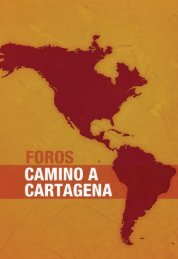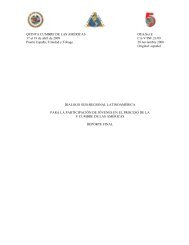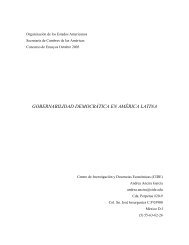The Road to Hemispheric Cooperation: Beyond the Cartagena
The Road to Hemispheric Cooperation: Beyond the Cartagena
The Road to Hemispheric Cooperation: Beyond the Cartagena
Create successful ePaper yourself
Turn your PDF publications into a flip-book with our unique Google optimized e-Paper software.
Brazil, in turn, leads an initiative focused on building environmentally<br />
sustainable low-income housing across Latin<br />
America and <strong>the</strong> Caribbean and reducing greenhouse gas<br />
emissions from solid waste. <strong>The</strong> American Planning Association<br />
provides technical assistance for <strong>the</strong> Brazilian housing<br />
initiative, with limited funding from <strong>the</strong> State Department.<br />
Chile has aggressively used ECPA <strong>to</strong> address energy-related<br />
matters affecting <strong>the</strong> country and its neighbors. For<br />
example, Chile hosts a regional Renewable Energy Center<br />
that receives technical assistance from <strong>the</strong> U.S. Department<br />
of Energy and has an open-access web site portal called<br />
“Open Energy Info” <strong>to</strong> facilitate <strong>the</strong> regional exchange of<br />
information on renewable energy resources. Chile also participates,<br />
along with Argentina, Colombia, Peru, <strong>the</strong> United<br />
States, and Uruguay, in an ECPA shale gas initiative that<br />
exchanges information on how <strong>to</strong> safely exploit shale gas<br />
reserves and minimize negative environmental impacts.<br />
In addition, Chile has joined Colombia, Ecuador, Panama,<br />
Peru, and <strong>the</strong> United States in exploring ways <strong>to</strong> interconnect<br />
all <strong>the</strong> national electric grids from Panama <strong>to</strong> Chile, beginning<br />
with harmonizing <strong>the</strong>ir respective regula<strong>to</strong>ry frameworks.<br />
<strong>The</strong> Union of South American Nations (UNASUR) is<br />
also pursuing a similar project, although Bolivia substitutes<br />
for Panama in that continental initiative.<br />
O<strong>the</strong>r ECPA projects include U.S.-based electric genera<strong>to</strong>r<br />
Sou<strong>the</strong>rn Company working with a Colombian nongovernmental<br />
organization <strong>to</strong> train disadvantaged secondary<br />
students for future careers in <strong>the</strong> energy sec<strong>to</strong>r. <strong>The</strong><br />
U.S. Department of Energy is working with <strong>the</strong> Ecuadorean<br />
Ministry of Coordination of Production, Employment and<br />
Competitiveness in turning residues generated by industrial<br />
processes in<strong>to</strong> valuable commodities or inputs.<br />
For its part, <strong>the</strong> Organization of American States (OAS)<br />
oversees implementation of <strong>the</strong> Caribbean Sustainable<br />
Energy Program (CSEP) funded primarily by <strong>the</strong> European<br />
Union, with some contributions from <strong>the</strong> U.S. Department<br />
of Energy, <strong>to</strong> enable <strong>the</strong> tiny island nations of <strong>the</strong> Eastern<br />
Caribbean and <strong>the</strong> Bahamas <strong>to</strong> increase <strong>the</strong> sustainability<br />
of <strong>the</strong>ir energy supplies while reducing carbon emissions<br />
through <strong>the</strong> development and use of renewable energy<br />
and energy efficiency systems. <strong>The</strong> OAS also oversees<br />
implementation of a Caribbean-wide program funded by<br />
<strong>the</strong> Energy Department <strong>to</strong> facilitate regional dialogue on<br />
long-term sustainable energy solutions, and <strong>to</strong> help national<br />
governments promote and implement sustainable energy<br />
policies and programs through short-term legal counseling<br />
and technical assistance. Overall, <strong>the</strong> OAS has emerged<br />
as a central clearinghouse for disseminating information on<br />
ECPA initiatives and bringing <strong>to</strong>ge<strong>the</strong>r potential public and<br />
private sec<strong>to</strong>r partners.<br />
Finally, <strong>the</strong> U.S. Peace Corps has an ECPA initiative that<br />
supports energy-efficient practices and <strong>the</strong> use of alternative<br />
energy technologies, including small-scale home or<br />
school solar solutions, cook s<strong>to</strong>ves, small wind turbines,<br />
and o<strong>the</strong>r energy efficiency solutions in Costa Rica, <strong>the</strong> Dominican<br />
Republic, Guyana, Honduras, Nicaragua, Panama,<br />
Peru, and Suriname. In Paraguay, <strong>the</strong> Peace Corps has<br />
also trained a group of small farmers <strong>to</strong> use a device called<br />
a bio-digester <strong>to</strong> properly treat organic waste and provide<br />
renewable energy and organic fertilizer.<br />
<strong>The</strong> <strong>Hemispheric</strong> Opportunity<br />
<strong>The</strong> Western Hemisphere has an abundant and diverse<br />
supply of both conventional and renewable energy resources.<br />
Roughly a third of <strong>the</strong> world’s proven reserves<br />
of oil are found in <strong>the</strong> Western Hemisphere. 13 Latin America<br />
alone accounts for just under 14 percent of world oil<br />
output but only consumes about half that. 14 Overall, Latin<br />
America and <strong>the</strong> Caribbean utilize about one-quarter of its<br />
<strong>to</strong>tal energy potential. 15 <strong>The</strong> extensive exploitation of natural<br />
gas from shale rock in <strong>the</strong> United States is expected<br />
<strong>to</strong> sharply reduce U.S. dependence on foreign energy imports<br />
and even make it an exporter of liquefied natural gas<br />
(LNG). Large shale rock formations—and presumably vast<br />
reserves of natural gas that can now be unlocked through<br />
hydraulic fracturing or “fracking”—are found throughout<br />
Argentina, Brazil, Canada, and Mexico.<br />
<strong>The</strong> discovery of major off-shore reserves of light oil and<br />
natural gas under miles of rock and salt formations in Brazil<br />
have <strong>the</strong> potential <strong>to</strong> make that country not only self-sufficient,<br />
but a major exporter of petroleum. Since 2006, Brazil<br />
has been self-sufficient in crude oil. Among <strong>the</strong> <strong>to</strong>p ten<br />
energy-consuming countries in <strong>the</strong> world, Brazil is also <strong>the</strong><br />
largest world economy whose energy matrix is <strong>the</strong> cleanest,<br />
with 85 percent of its electricity generated by hydropower<br />
and a whopping 60 percent of its <strong>to</strong>tal energy consumption<br />
coming from renewable sources. 16<br />
<strong>The</strong> <strong>Road</strong> <strong>to</strong> <strong>Hemispheric</strong> <strong>Cooperation</strong>: <strong>Beyond</strong> <strong>the</strong> <strong>Cartagena</strong> Summit of <strong>the</strong> Americas<br />
<strong>The</strong> Brookings Institution ❘ Latin America Initiative<br />
49








